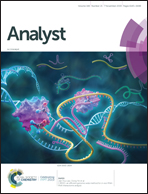A colorimetric probe for the real-time naked eye detection of cyanide and hydroxide ions in tap water: experimental and theoretical studies
Abstract
Herein, a colorimetric sensor (L) based on a naphthyl derivative bearing hydrazone receptors was synthesized via a one-step reaction process, and its recognition properties towards biologically important anions in an acetonitrile–water mixture were investigated by naked-eye observation and UV-Vis and 1H NMR spectroscopy. The molar addition of anions, such as TBAF−, TBAOH−, TBACN− and TBAAcO−, induced a significant red shift in the charge transfer band (Δλ = 73 nm, from 337 nm to 410 nm), in agreement with visible “naked eye” detectable colorimetric activities; in addition, soaked-in-L paper strips were prepared, which could significantly discriminate cyanide (KCN) and hydroxide (NaOH) ions dissolved in tap water via the litmus test method. This study was complemented by density functional theory computations to gain more insight into the interaction between L and anions.



 Please wait while we load your content...
Please wait while we load your content...